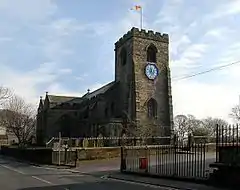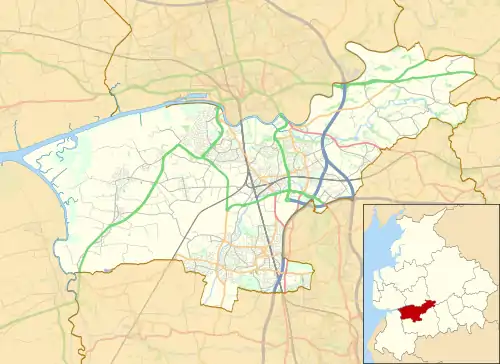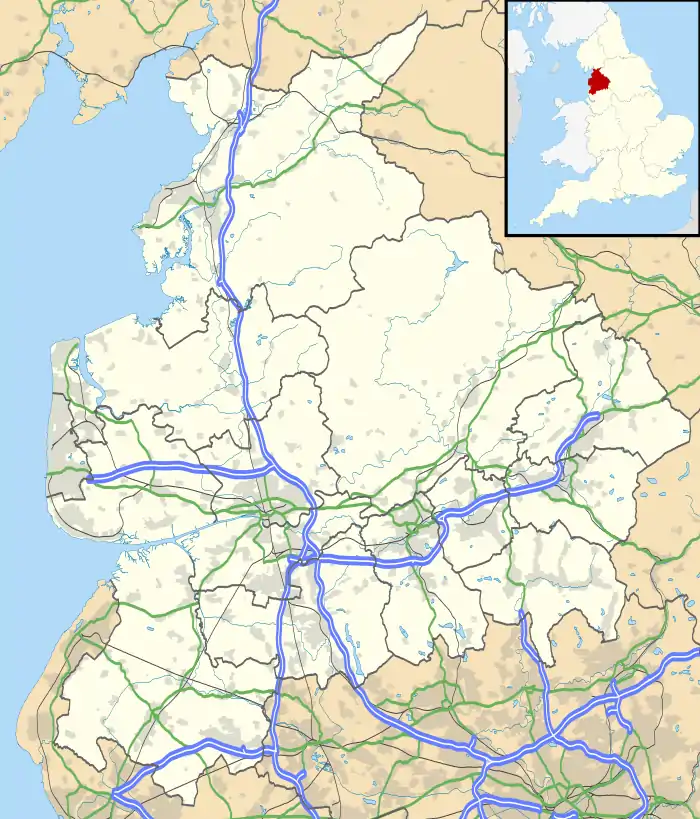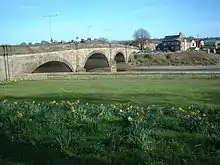Walton-le-Dale
Walton-le-Dale is a large village in the Borough of South Ribble, in Lancashire, England. It lies on the south bank of the River Ribble, opposite the city of Preston, adjacent to Bamber Bridge. The population of the South Ribble Ward at the 2011 census was 3,792.[1] To the west of Walton-le-Dale is the residential area of Walton Park.
| Walton-le-Dale | |
|---|---|
 St Leonard's Church, Walton-le-Dale | |
 Walton-le-Dale Shown within South Ribble  Walton-le-Dale Location within Lancashire | |
| Population | 3,792 (2011, Ward) |
| OS grid reference | SD562280 |
| District | |
| Shire county | |
| Region | |
| Country | England |
| Sovereign state | United Kingdom |
| Post town | PRESTON |
| Postcode district | PR5 |
| Dialling code | 01772 |
| Police | Lancashire |
| Fire | Lancashire |
| Ambulance | North West |
| UK Parliament | |
History
Toponymy
Walton is derived from walh and tun and means the farmstead or settlement of the Britons. It was recorded in the Domesday Book as Waletune. In the 13th century it was recorded as Waleton and since about 1300 Waleton in le (la) Dale, or Walton in the valley.[2]
Early history
The remains of a Roman fort at the junction of the River Darwen and River Ribble at Walton-le-Dale were discovered by accident in the mid 19th century. Roman remains found here include pottery and coins.[3] The fort may have been the Rigodunum of Ptolemy,[2] although most people locate it at Castleshaw.
Manor
Two oxgangs of land in Walton belonged to King Edward the Confessor in 1066, and after the Norman conquest, was the demesne of Roger de Busli and Albert Grelley. The manor passed in about 1130 to Henry de Lacy of Pontefract and was later granted to the Banastres and their successors the Langtons. John de Langton obtained the right to hold a weekly market and an annual fair in October in 1301. The manor passed from the Langtons to the Hoghtons of Hoghton who held the manor as mesne lord.[2]
Battles

During the English Civil War the bridges over the river were the scene of skimishes between the Royalists and Roundheads. In 1644 Royalists were captured by Parliamentarians and Walton was the principal scene of the first Battle of Preston, fought on 17 August 1648 between Cromwell and the Duke of Hamilton.[2]
In 1715, during the second Battle of Preston, the bridge over the River Ribble was successfully defended against the Jacobites by Parson Wood and his parishioners of Chowbent.[4]
Industrial Revolution
During the Industrial Revolution there were four cotton mills, including Flats Mills belonging to William Calvert which employed 400 workers and James Livesey and Son's Moon Mill employing 130 workers. There was a cotton printing business and in 1800 Robert Whittaker established an iron foundry.[4]
Governance
Anciently Walton-le-Dale was a township and chapelry in the parish of Blackburn and a part of the hundred of Blackburnshire.[2] In 1701 the Duke of Norfolk, the Earl of Derwentwater and other Jacobites incorporated the town by the style of the "mayor and corporation of the ancient borough of Walton."[5]
It became part of the Preston Poor Law Union, formed in 1837, which took responsibility for the administration and funding of the Poor Law and built a workhouse in that area.[6] A local board was formed in 1877, and in 1894 an urban district council of twelve members representing four wards was formed.[2] Walton-le-Dale was in the Darwen parliamentary division of Lancashire. Since 1974 the local council is South Ribble based in Leyland and the area is part of the Ribble Valley parliamentary constituency.
Transport
Walton-le-Dale is served regularly by Stagecoach Merseyside & South Lancashire and Blackburn Bus Company buses. The Park & Ride service into Preston City Centre is located in Walton-le-Dale, at the Capitol Centre retail park.[7] The Capitol Centre is a large retail and leisure facility, which was built on the site of the former Flats Mills.
Religion
The church of St Leonard, situated on high ground to the east of the village, was originally erected in the 11th century. The earliest portions of the present building are the Perpendicular chancel and tower, the nave having been rebuilt in 1798, while the transepts were erected in 1816. There are a number of interesting old brasses and monuments.[5]
The church of Our Lady and St Patrick is located on Higher Walton Road in the village. Originally formed in 1855 by the Benedictine order, the Parish of Our Lady and St Patrick (originally the Mission of St Patrick) includes both The Pugin Church of Our Lady and St Patrick and St Patrick's RC Primary School, and has served Walton-le-Dale and surrounding area for over 150 years.
Culture
In 1701 some of the local gentry including the Duke of Norfolk, the Earl of Derwentwater and other Jacobites formed the Mock Borough of Walton, a social club, which lasted for about 50 years, and met in the Unicorn Inn, near Darwen Bridge.[4] The mock corporation had officers which included a mayor, his deputy, recorder, bailiff, chaplain, serjeant, physician and mace-bearer but which also appointed a house-groper, jester, poet laureate, master of the hounds, sword-bearer, in 1708 a slut-kisser and in 1711 a custard-eater.[2]
Legends
At midnight on 12 August 1560, under the moonlight in St Leonard's Churchyard, occultist and scholar Dr John Dee summoned the spirit of a man who had died before giving the whereabouts of a considerable amount of money. It is said that he was successful and the spirit did indeed tell the occultist the whereabouts of the wealth, but not before also predicting to Dee the fate of many of the locals, which is said to have later come true. This section incorporates text from the 1911 Encyclopædia Britannica, which is in the public domain.
Notable people
- Corporal John McNamara VC (1887–1918) recipient of the Victoria Cross was born here.
- Edward Baines (1774–1848), newspaper proprietor and politician, was born here.
- Joseph Livesey (1794–1884), temperance campaigner, social activist, writer, publisher and local cheese seller, was born here.
- Ian McCulloch, 2005 World Snooker Championships Semi-Finalist, was born here.
- Samuel Ryder (1858–1936), mayor and sponsor of the Ryder Cup was born here.
See also
References
- "South Ribble Ward population 2011". Retrieved 17 January 2016.
- Farrer, William; Brownbill, J, eds. (1911), "Townships: Walton-le-Dale", A History of the County of Lancaster: Volume 6, British History Online, pp. 149–153, retrieved 2 October 2011
- Monument no. 42462, Pastscape.org.uk, retrieved 2 October 2011
- Lewis, Samuel (1848), "Walton-Le-Dale", A Topographical Dictionary of England, British History Online, pp. 453–457, retrieved 2 October 2011
-
 One or more of the preceding sentences incorporates text from a publication now in the public domain: Chisholm, Hugh, ed. (1911). "Walton-le-Dale". Encyclopædia Britannica. 28 (11th ed.). Cambridge University Press. p. 301.
One or more of the preceding sentences incorporates text from a publication now in the public domain: Chisholm, Hugh, ed. (1911). "Walton-le-Dale". Encyclopædia Britannica. 28 (11th ed.). Cambridge University Press. p. 301. - Workhouse, Workhouses.org, retrieved 1 October 2011
- "Capitol Centre". Capitol Centre, Walton-le-Dale. Retrieved 10 September 2020.
External links
| Wikimedia Commons has media related to Walton-le-Dale. |